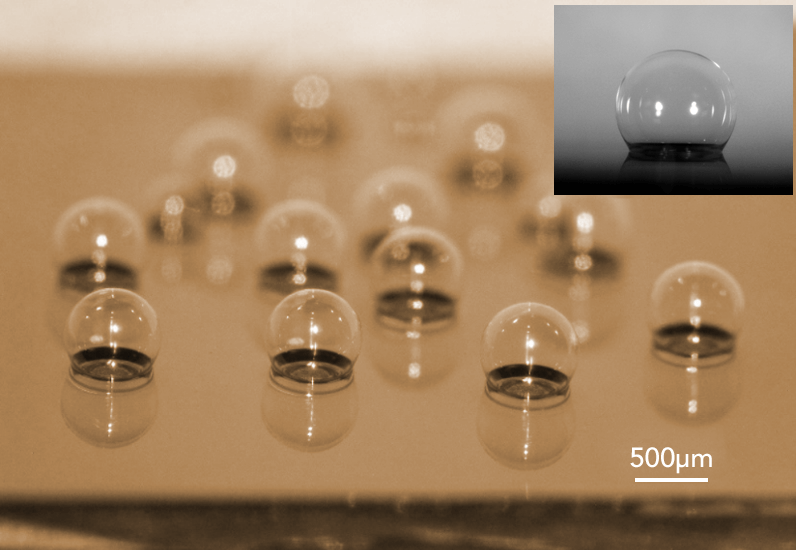Nov 3 2017
A whisper can be heard in St. Paul's Cathedral, at London, from far across the circular whispering gallery as the sound curves around the walls. An optical whispering gallery mode resonator has presently been developed by Penn State electrical engineers. This resonator is capable of spinning light around the circumference of a small sphere millions of times, developing an ultrasensitive microchip-based sensor for an extensive range of applications.
 Chip-scale glass microspherical shell sensor array blown on a silicon substrate. Insert is a near-perfect spherical shell. Image: Tadigadapa Lab / Penn State
Chip-scale glass microspherical shell sensor array blown on a silicon substrate. Insert is a near-perfect spherical shell. Image: Tadigadapa Lab / Penn State
Whispering gallery mode resonators, which are basically optical resonators, have been intensely studied for at least 20 years, what people have done is to take an optical fiber and touch the end with a blow torch. When the melted fiber re-condenses, it forms a sphere at the tip. This can be coupled to a light source to make a sensor.
Srinivas Tadigadapa, professor of electrical engineering.
That type of sensor comprises of solid spheres and is not well-matched with microfabrication methods, but Tadigadapa and his team recently came up with an advanced way to grow on-chip glass microspherical shells with excellent sensitivities that can be used potentially for motion, pressure, temperature or biochemical sensing.
The hollow borosilicate glass spheres are blown from pressurized, sealed cylindrical cavities fixed into a silicon substrate. With the help of a glassblowing technique, the thin glass wafer, under external vacuum pressure and high heat, produces an almost perfect bubble. Arrays of spheres from 230 μm to 1.2 mm in diameter with wall thicknesses ranging between 300 nm and 10 μm were grown by the researchers.
The bottom of the sphere is thinned until it is basically a hole, you can put the light on the outside of the sphere but do all the chemistry on the inner face of the shell. You can bring in any analyte that you want to identify, but it goes on the inner surface. That brings in a lot of possibilities. You can do chemical sensing, vapor sensing, biophysical sensing, pressure sensing and really outstanding temperature sensing.
Srinivas Tadigadapa, professor of electrical engineering.
Following a number of failed attempts, the team was able to discover that the key to developing a superior-quality sensor exists in ensuring that the equatorial plane of the sphere, its center, is above the chip’s surface.
Tadigadapa's doctoral student Chenchen Zhang and recent doctoral graduate Eugene Freeman woked with Alexander Cocking, a doctoral student in the lab of Penn State laser expert Zhiwen Liu, professor of electrical engineering in order to understand the quality of their spheres.
"We make the bubbles and then take them to Dr. Liu's lab to get the resonance levels and make the measurements," stated Zhang, key author on a paper describing their work, which appears in the Nov 2, 2017, edition of Scientific Reports, an online, open access journal.
This result will have specific importance for lab-on-a-chip biophysical sensing for disease sensing, Zhang stated. "Or by adding a polymer coating on the inside of the bubble, you could make a really sensitive humidity sensor."
There are some really exciting possibilities. I think it will spawn a large follow-up work.
Srinivas Tadigadapa, professor of electrical engineering
All the researchers on the paper "On-Chip Glass Microspherical Shell Whispering Gallery Mode Resonators" are from the School of Electrical Engineering and Computer Science and the Materials Research Institute, Penn State.